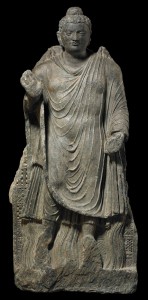 In a break from the usual pattern, an art dealer who has chosen to remain anonymous put his freedom and career on the line to rescue an ancient Buddha statue looted from the National Museum of Afghanistan in Kabul during the 1990s.
In a break from the usual pattern, an art dealer who has chosen to remain anonymous put his freedom and career on the line to rescue an ancient Buddha statue looted from the National Museum of Afghanistan in Kabul during the 1990s.
The rare 4-foot statue of Gandharan Buddha with flames coming off his shoulders and water flowing from his feet dates to the 2nd century A.D. It was stolen at some time during the civil wars after the fall of the Soviet-backed Najibullah regime in 1992 and had traveled the dark halls of the black market in antiquities until it was recently purchased by a Japanese private collector. A Japanese dealer sent our hero a picture of the statue and he immediately recognized it from his years of travel in Afghanistan. He even remembered exactly where it had been displayed in the National Museum.
He contacted the collector and told him that the piece had been stolen, begging him to return it to the museum. Appeals to giving a damn about the cultural heritage of a war-torn nation fell on deaf ears. The collector refused to give it up. Under Japanese law, owners cannot be prosecuted for purchasing a stolen artifact even if there’s concrete proof that the item was looted.
The UK, on the other hand, has laws against buying stolen goods, but faced with the prospect of this precious piece of Afghan heritage disappearing into a private collection forever, the British art dealer (heretofore known as BAD, like in BADASS) decided he had to take the risk of being arrested to save the Buddha and return it to Kabul where it belonged. He offered to buy the statue from the Japanese collector.
He told two people of his plan: Neil MacGregor, the director of the British Museum and St John Simpson, a curator. They sought legal counsel only to receive confirmation that there was nothing they could do to protect themselves. Getting mixed up in this deal was illegal and they could get in big trouble, despite their best intentions. They decided the public good was more important than holding to the letter of the law, so they supported BAD’s attempt to buy the statue. He spent a year negotiating with the collector, and finally he was able to secure the sale using only his own money.
There are no details in the article about how the artifact was imported, possibly because said import was technically smuggling, but whatever they did worked.
Simpson described the rescue as “terribly appropriate”, coming as it did on the 10th anniversary of the Taliban’s destruction of the Bamiyan Buddhas in Afghanistan: “They’re gone forever. But one very important piece can be returned. This is a very important and stunningly beautiful piece.”
Omara Khan Massoudi, director of the National Museum of Afghanistan, described it as “one of our most treasured objects”. One source put the sculpture’s value at £600,000, but the British Museum said it is “without value, given its provenance”.
The Buddha is now safe in the hands of the British Museum where it will go on display Wednesday as part of its hugely successful Afghanistan: Crossroads of the Ancient World, which has been so popular the museum extended its run through July 17. The Gandharan Buddha will be returned to the National Museum in Kabul along with the rest of the exhibits.